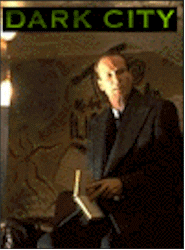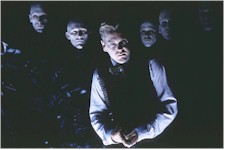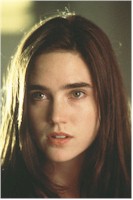|
| |
Dark City
Review by Elias Savada
Posted 27 February 1998
 |
|
Directed by Alex Proyas Starring
Rufus Sewell, Kiefer Sutherland,
Jennifer Connelly, and William Hurt
Screenplay by Alex Proyas, Lem Dobbs and
David S. Goyer. Story by Alex Proyas |
The Crow, director Alex Proyas' acclaimed
American debut feature was one of my favorite films of 1994, and that despite the untimely
death of its star Brandon Lee almost dooming the film to realm of the unreleased. With Dark
City he returns to his native Australia and Proyas has crafted a dark, fantastic
world that immediately engages your imagination. Part sci-fi thriller, part haunting 1940s
film noir set piece, Dark City has lots of pizzazz, but too little punch. It's as
if the world's heavyweight champion, on the verge of the knockout, throws in the towel.
For all the marvelous production design, awe-inspiring special effects, effectively-lit
camera work, and hellish makeup, I left the movie empty of satisfaction, a Blade Runner
gone awry ... Twilight Zone without Rod Serling.
The plot blends elements from Kafka and H.G. Wells with a dash of Dashiell Hammett, and
it does demand more than a casual viewing to both absorb the paranoid, comic book fantasy
and the extensive landscape of the operating theater where the mental surgery occurs. It's
a world of nightmares and lost memories, the manifestation of an alien race known as The
Strangers, who
experiment on a city of amnesiacs. John Murdock (Rufus Sewell) awakens in a room with a
dead hooker and immediately goes on the defensive from accordion-playing Police Inspector
Frank [why not Dagwood!] Bumstead (William Hurt) and also from the mass of gangly,
leather-clad, pale-faced, bald-headed, raspy-voiced Strangers, all retro bedecked in
deference to Max Schreck's vampire in Nosferatu (1922). Every night at midnight (did you
expect maybe 2:13 AM?), the puppet-masters engage in a telepathic, teeth-chattering group
mind meld in their vast subterranean lair. The unnamed Metropolis slows to a stop —
cars brake, people freeze in their places or plop into their food. John has managed to
unstick himself from the Strangers' thoughts and while trying to pull his confused mind
together discovers that he has been endowed with the alien ability to Tune, i.e.
telepathically alter reality. When the bad guys Tune, the earth literally moves and shakes
— buildings erupt and disappear, walls reshape, neighborhoods change in an instant.
They are aided by Dr. Daniel Schreber (Kiefer Sutherland), a wimpy, limpy sell-out in the
Renfield/Mad Scientist role. The doctor may be stilted in speech, but he manages to mix up
the nocturnal batches of conveyor-belt memories that are imprinted into all the human
guinea pigs during the nightly time out. Seems they are on a holy quest for the human
soul. Not much is put into their reason for this who charade beyond that. who
experiment on a city of amnesiacs. John Murdock (Rufus Sewell) awakens in a room with a
dead hooker and immediately goes on the defensive from accordion-playing Police Inspector
Frank [why not Dagwood!] Bumstead (William Hurt) and also from the mass of gangly,
leather-clad, pale-faced, bald-headed, raspy-voiced Strangers, all retro bedecked in
deference to Max Schreck's vampire in Nosferatu (1922). Every night at midnight (did you
expect maybe 2:13 AM?), the puppet-masters engage in a telepathic, teeth-chattering group
mind meld in their vast subterranean lair. The unnamed Metropolis slows to a stop —
cars brake, people freeze in their places or plop into their food. John has managed to
unstick himself from the Strangers' thoughts and while trying to pull his confused mind
together discovers that he has been endowed with the alien ability to Tune, i.e.
telepathically alter reality. When the bad guys Tune, the earth literally moves and shakes
— buildings erupt and disappear, walls reshape, neighborhoods change in an instant.
They are aided by Dr. Daniel Schreber (Kiefer Sutherland), a wimpy, limpy sell-out in the
Renfield/Mad Scientist role. The doctor may be stilted in speech, but he manages to mix up
the nocturnal batches of conveyor-belt memories that are imprinted into all the human
guinea pigs during the nightly time out. Seems they are on a holy quest for the human
soul. Not much is put into their reason for this who charade beyond that.
The oversized city stage — the largest indoor set ever built in Australia —
does entrance. Production designers George Liddle and Patrick Tatopoulos (Independence Day) are part of the technical mix that includes longtime
(in music videos and commercials) collaborator costume designer Liz Keogh and from The
Crow, director of photography Dariusz Wolski (Crimson Tide) and editor Dov Hoenig (Heat and The Fugitive). Everyone does a top notch
job, and the gargantuan creation might just give Titanic
it's first real taste of competition. The cast, regrettably, held hostage inside this
Edvard Munch world. Green-eyed Sewell, the musk hulk presence in Cold Comfort Farm
does appear to have been truly discovered by Hollywood, as he is also starring in the long
delayed Dangerous Beauty. He gets to push a gondola in both flicks and it seems
he gets left holding the stick, more so in the Venetian pseudo-epic (a Cliff's Notes
version at that). Connelly has run hot, cold, and steamy since her debut in Sergio Leone's
Once Upon a Time in America (1984). She's a sexy bauble as the voluptuous
chanteuse Emma and John's doting wife. She isn't offered much to work with. Even her
singing voice gets dubbed. The Strangers all fall from the same mold and are named after
short words — Mr. Hand (Richard O'Brien), Mr. Book (Ian Richardson), Mr. Wall (Bruce
Spence) among their leaders, but also assisted by Messrs. Rain, Sleep, and Quick. They're
mean, lean, and floating machines. are part of the technical mix that includes longtime
(in music videos and commercials) collaborator costume designer Liz Keogh and from The
Crow, director of photography Dariusz Wolski (Crimson Tide) and editor Dov Hoenig (Heat and The Fugitive). Everyone does a top notch
job, and the gargantuan creation might just give Titanic
it's first real taste of competition. The cast, regrettably, held hostage inside this
Edvard Munch world. Green-eyed Sewell, the musk hulk presence in Cold Comfort Farm
does appear to have been truly discovered by Hollywood, as he is also starring in the long
delayed Dangerous Beauty. He gets to push a gondola in both flicks and it seems
he gets left holding the stick, more so in the Venetian pseudo-epic (a Cliff's Notes
version at that). Connelly has run hot, cold, and steamy since her debut in Sergio Leone's
Once Upon a Time in America (1984). She's a sexy bauble as the voluptuous
chanteuse Emma and John's doting wife. She isn't offered much to work with. Even her
singing voice gets dubbed. The Strangers all fall from the same mold and are named after
short words — Mr. Hand (Richard O'Brien), Mr. Book (Ian Richardson), Mr. Wall (Bruce
Spence) among their leaders, but also assisted by Messrs. Rain, Sleep, and Quick. They're
mean, lean, and floating machines.
While Proyas tunes in a battle royale in the mindfight at the Strangers' Corral, he is
failed to engage me in a thought provoking piece. The ultimate discovery and quest for
Shell Beach, John's fuzzy, sun-drenched childhood home seems like a color-drained
tacked-on afterthought. All through the film he's asking everyone how to get there and no
one remembers. Like the Strangers, Proyas and his screenwriters have failed to find a key
component in this dazzling film — a soul.
Contents | Features
| Reviews | News | Archives | Store
Copyright © 1999 by Nitrate Productions, Inc. All Rights
Reserved.
| |
|